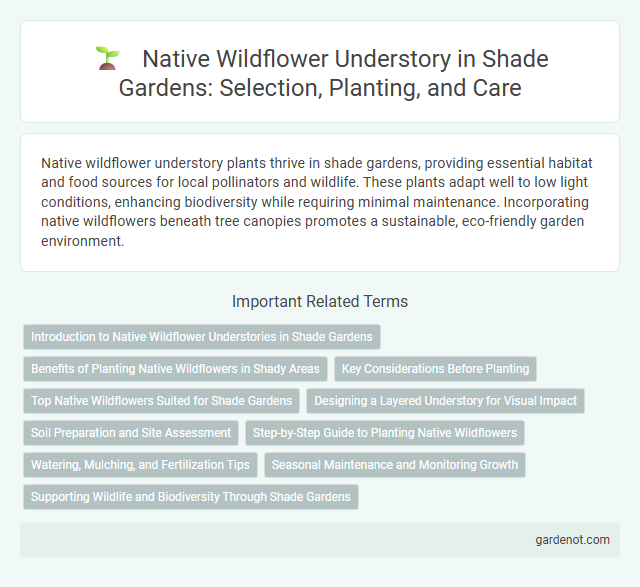Native wildflower understory plants thrive in shade gardens, providing essential habitat and food sources for local pollinators and wildlife. These plants adapt well to low light conditions, enhancing biodiversity while requiring minimal maintenance. Incorporating native wildflowers beneath tree canopies promotes a sustainable, eco-friendly garden environment.
Introduction to Native Wildflower Understories in Shade Gardens
Native wildflower understories thrive in shade gardens by adapting to low-light conditions beneath tree canopies, supporting biodiversity and soil health. Species such as Trillium, Solomon's Seal, and Bloodroot provide seasonal color and attract pollinators while enhancing ecosystem stability. Incorporating native wildflowers into shade gardens promotes natural habitat restoration and reduces maintenance needs through ecological compatibility.
Benefits of Planting Native Wildflowers in Shady Areas
Planting native wildflowers in shady garden understories enhances biodiversity by providing essential habitat and food sources for local pollinators and wildlife. These species are well-adapted to low-light conditions, requiring less water and maintenance compared to non-native plants, promoting sustainable landscaping. Native wildflowers also improve soil health and prevent erosion, contributing to a resilient and ecologically balanced shade garden environment.
Key Considerations Before Planting
Selecting native wildflower understory plants requires careful evaluation of the shade zone's light intensity, soil moisture, and texture to ensure optimal growth conditions. Understanding the natural habitat and ecological role of species like Trillium, Virginia Bluebell, and Foamflower helps maintain biodiversity and supports local pollinators. Proper site preparation, including mulching and avoiding invasive species, is crucial for establishing a resilient and sustainable shade garden understory.
Top Native Wildflowers Suited for Shade Gardens
Top native wildflowers suited for shade gardens include Trillium, Bloodroot, and Jack-in-the-pulpit, which thrive in low-light conditions while providing vibrant seasonal blooms. These species support local pollinators such as bees and butterflies, contributing to a healthy ecosystem. Selecting native wildflower understory plants enhances soil health and requires less maintenance compared to non-native alternatives.
Designing a Layered Understory for Visual Impact
In shade garden design, incorporating a native wildflower understory creates a vibrant, layered effect that enhances visual depth and biodiversity. Selecting shade-tolerant wildflowers such as Trillium, Wild Ginger (Asarum canadense), and Bloodroot (Sanguinaria canadensis) promotes a naturalistic aesthetic and supports local pollinators. Strategically layering these plants by height and bloom time maximizes color variation and ecological function throughout the growing season.
Soil Preparation and Site Assessment
Assess soil texture, pH, and moisture levels to create optimal conditions for a native wildflower understory in shade gardens. Amend soil with organic matter such as compost or leaf mold to improve drainage and nutrient availability, ensuring a fertile environment. Remove competing vegetation and test for soil compaction to enhance root establishment and promote healthy growth of native wildflowers.
Step-by-Step Guide to Planting Native Wildflowers
Choose shade-tolerant native wildflower species such as Trillium, Virginia Bluebells, and Foamflower to create a thriving understory in your shade garden. Prepare the soil by removing debris, loosening the top layer, and ensuring rich organic matter to support healthy root development. Sow seeds evenly in early spring or fall, lightly cover with soil, and maintain consistent moisture to encourage strong germination and growth.
Watering, Mulching, and Fertilization Tips
Native wildflower understory in shade gardens thrives with consistent watering that keeps the soil moist but not waterlogged, especially during dry periods. Applying a 2-3 inch layer of organic mulch, such as shredded leaves or bark, helps retain soil moisture, suppress weeds, and regulate soil temperature. Fertilize sparingly using a balanced, slow-release fertilizer or compost to promote healthy growth without encouraging excessive foliage at the expense of flowers.
Seasonal Maintenance and Monitoring Growth
Native wildflower understories in shade gardens require seasonal maintenance that includes mulch replenishment and removal of invasive species to support healthy growth cycles. Monitoring growth involves regular observation during spring and fall to assess plant vigor, detect pest infestations, and ensure appropriate moisture levels are maintained. Implementing these practices promotes a thriving understory that enhances biodiversity and soil health.
Supporting Wildlife and Biodiversity Through Shade Gardens
Native wildflower understories in shade gardens create essential habitats that support pollinators like bees, butterflies, and hummingbirds. These plants improve soil health and provide food and shelter for native insects and small mammals, enhancing local biodiversity. Integrating diverse native species in shaded areas fosters resilient ecosystems vital for urban and suburban wildlife conservation.
Native wildflower understory Infographic

 gardenot.com
gardenot.com